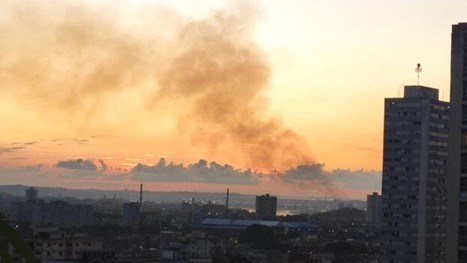Turkish ‘Patanas’ Are a Pollution Bomb in Cuba
In addition to being expensive

The floating power plants release dangerous amounts of carbon monoxide and nitrogen oxide into the island’s atmosphere
HAVANA TIMES – The formidable column of smoke that extends from the bay of Havana to the east is the most visible example of the environmental damage caused by the Turkish patanas, the floating power plants present on the Island since 2019. The chimneys of the Suheyla Sultan, generating 240 megawatts (MW) and connected to the Tallapiedra thermoelectric plant, throw considerable amounts of carbon monoxide (CO) and nitrogen oxide (NOx), two dangerous pollutants, into the atmosphere.
Despite the risk of toxicity, the authorities – who rent five of the same type from the company Karpowership for an estimated annual price of 31 million dollars – have installed the patanas in the ports of their two most populated cities, Santiago de Cuba and Havana, and in the Mariel Special Development Zone.
To gauge the damage in the absence of official reports, 14ymedio consulted the legal process faced by Karpowership in the Dominican Republic over two patanas in Pueblo Viejo de Azua, a protected coastal area. Despite the fact that the Dominican Ministry of the Environment granted the license to install two patanas (with a total of 180 MW, barely a third of the installed capacity in Cuba), the protests of activists, scientists, fishermen and inhabitants of the area remain red hot.
According to the government commission that approved the project, the patanas have chimneys that are 55 meters high and 1.8 meters in diameter, and emit into the atmosphere 100 milligrams of NOx per cubic meter and 290 of CO at a temperature of 45 ºC.
Given these values, Karpowership did not commit to anything, and the experts limited themselves to stating that “the emission of burning gases during the normal operation of the patanas is expected to have emissions of atmospheric pollutants such as CO and NOx. The emission levels of pollutants (carbon monoxide and nitrogen oxide) are expected to be below the maximum limits established” by the Dominican Environmental Technical Regulation.
However, the company had to pay a total of $5,275,000 to an “environmental adequacy” program that included a contingency plan, risk analysis, preventive measures against climate change and money for possible restorations.
Judging by the trace of hazy smoke that covers Havana, it is unlikely that Cuba, which, unlike the Dominican Republic, maintains total secrecy about the contract signed with the Turkish company, has taken similar measures to prevent these pollution levels. Another important difference between the two countries: while the Cuban population does not seem to worry about the cloud of pollution that covers Havana, protests continue in the Dominican Republic against the Karpowership patanas.
At the end of 2022, one of the plants, the Irem Sultan, had to temporarily leave the Dominican Republic after several riots led by residents in Azua, and it came to Havana. It could not return until the managers of Karpowership obtained the environmental license.

Last May, after several statements by the Human Rights Commission of the Dominican Parliament, the Deputy Minister of Environmental Management, Indira de Jesús, had to present new arguments to justify the patanas, saying that they did not affect the protected area of Azua.
However, the newspaper Al Momento revealed that both power plants and support boats incur “permanent spills” of fuel, in addition to generating a coastal current that passes through the interior of the ships to cool their boilers, and that absorbs and burns, during suction, hundreds of fish and other species. The effect of this process is a remarkable warming of the water, which decreases its oxygen levels and damages the fauna of the coast.
Among the most affected animals has been the manatee, in danger of extinction; they feed on vegetation in mangroves located less than 100 meters from the patanas. The Academy of Sciences of the Dominican Republic also denounced the damage to the habitat of lobsters and crabs, which are very sensitive to water temperature.
The pollution is also affecting the inhabitants of the area, dependent on fishing, who have demanded a response from the authorities on multiple occasions for the findings of dead or poisoned fish on the coast.
In the Dominican Republic, “hope is placed in the justice system,” which can call to account the officials who authorized the installation of the patanas and the rulers who signed the permits, even though they are aware of the damage. However, in Cuba, where the courts respond to the regime and no expert has dared to denounce the environmental disaster caused by the patanas, the chimneys of the Suheyla Sultan will continue to throw toxins into the sky of Havana with impunity.
Translated by Regina Anavy for Translating Cuba





